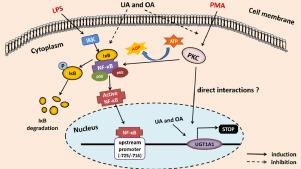Phytomedicine ( IF 6.7 ) Pub Date : 2021-08-25 , DOI: 10.1016/j.phymed.2021.153726 Li Yuan 1 , Lingming Zhang 1 , Na Yao 1 , Lingna Wu 1 , Jianming Liu 1 , Fanglan Liu 1 , Hong Zhang 1 , Xiao Hu 1 , Yuqing Xiong 1 , Chunhua Xia 1

|
Background
Isomeric ursolic acid (UA) and oleanolic acid (OA) compounds have recently garnered great attention due to their biological effects. Previously, it had been shown that UA and OA can exert important pharmacological action via the protein kinase C (PKC) and nuclear factor-κB (NF-κB) signaling, and that they can induce the expression of UDP-glucuronosyltransferase 1A1 (UGT1A1) in HepG2 cells. This study aims to investigate the role of PKC/NF-κB signaling in regulating the expression of UGT1A1 and examine how UA and OA induce UGT1A1 based on this signaling pathway.
Methods
HepG2 cells, hp65-overexpressed HepG2 cell and lentivirus-hp65-shRNA silenced HepG2 cells were stimulated with PKC/NF-κB specific agonists and inhibitors for 24 h in the presence or absence of UA and OA. The expression of UGT1A1, PKC, and NF-κB were determined by qRT-PCR, western blot, and dual-luciferase reporter gene assays.
Results
PKC/NF-κB activation downregulates UGT1A1 expression. This effect is countered by UA and OA treatment. Phorbol 12-myristate 13-acetate (PMA) and lipopolysaccharide (LPS), the agonists of PKC and NF-κB signaling, respectively, significantly inhibit hp65-mediated UGT1A1 luciferase activity. UA, OA, and the PKC/NF-κB inhibitors suppress this effect. PMA and LPS do not affect UGT1A1 activity in p65-silenced HepG2 cells; however, UA and OA mildly influence UGT1A1 expression in these cells.
Conclusion
The activation of PKC/NF-κB signaling can significantly downregulate UGT1A1 expression. By inhibiting the PKC/NF-κB signaling pathway, UA and OA promote UGT1A1 expression in HepG2 cells.
中文翻译:

熊果酸和齐墩果酸通过抑制 PKC/NF-κB 信号通路上调 UGT1A1 表达
背景
异构熊果酸(UA)和齐墩果酸(OA)化合物最近由于其生物效应而引起了极大的关注。此前已有研究表明,UA和OA可以通过蛋白激酶C(PKC)和核因子-κB(NF-κB)信号传导发挥重要的药理作用,并且可以诱导UDP-葡萄糖醛酸基转移酶1A1(UGT1A1)的表达在 HepG2 细胞中。本研究旨在探讨PKC/NF-κB信号通路在调节UGT1A1表达中的作用,并探讨UA和OA如何基于该信号通路诱导UGT1A1。
方法
在存在或不存在 UA 和 OA 的情况下,用 PKC/NF-κB 特异性激动剂和抑制剂刺激 HepG2 细胞、hp65 过表达的 HepG2 细胞和慢病毒-hp65-shRNA 沉默的 HepG2 细胞 24 小时。通过 qRT-PCR、蛋白质印迹和双荧光素酶报告基因检测测定 UGT1A1、PKC 和 NF-κB 的表达。
结果
PKC/NF-κB 激活下调 UGT1A1 表达。 UA 和 OA 治疗可以抵消这种影响。佛波醇 12-肉豆蔻酸酯 13-乙酸酯 (PMA) 和脂多糖 (LPS) 分别是 PKC 和 NF-κB 信号传导的激动剂,可显着抑制 hp65 介导的 UGT1A1 荧光素酶活性。 UA、OA 和 PKC/NF-κB 抑制剂可抑制这种作用。 PMA 和 LPS 不影响 p65 沉默的 HepG2 细胞中的 UGT1A1 活性;然而,UA 和 OA 轻微影响这些细胞中 UGT1A1 的表达。
结论
PKC/NF-κB信号的激活可以显着下调UGT1A1的表达。 UA和OA通过抑制PKC/NF-κB信号通路促进HepG2细胞中UGT1A1的表达。











































 京公网安备 11010802027423号
京公网安备 11010802027423号